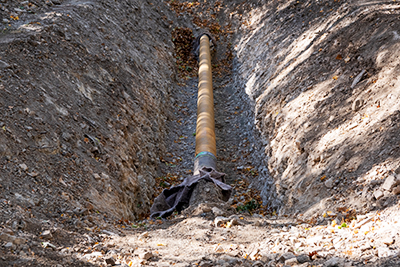In 1984, the City of Worcester began planning to protect, preserve and expand its supply of potable water. The Safe Drinking Water Act Amendments of 1986 dictated that all surface water supplies must use filtration to treat drinking water if they cannot meet highly stringent water quality and reliability criteria.
The new filtration plant was designed to be environmentally and aesthetically compatible with its natural setting. Pretreatment, combined with direct filtration through a deep-bed anthracite filter, were the most effective and economical water treatment processes for Worcester.
Water Treatment Facts
- Plant Flow - 50 Million Gallons Per Day (MGD)
- Reservoir System - The treatment plant utilizes a series of ten surface water reservoirs located in Leicester, Paxton, Rutland, Holden and Princeton. The ten reservoirs combined, hold over 7 billion gallons of water.
- Treated Water Storage - Two, 2.75-million-gallon storage tanks.
Worcester's primary source of drinking water is derived from Worcester's Lynde Brook Reservoir and the Holden reservoir system. The preozonation process treats the water with ozone, a powerful disinfectant. The water then goes through coagulation via a rapid mix process to treat organic materials, and then flocculation to form floc particles which can be filtered out. Next, the water is filtered, treated to control corrosion and finally given post-disinfection treatment by chlorine.
Water Conservation
Our control over water usage doesn't end at the faucet. There are several measures you can take in and around your home that will significantly reduce waste, and save you money.
Tips
- Bathroom facilities claim nearly 75% of the water used. An ultra-low flush toilet can cut your family's total indoor water use by as much as 20%.
- Don't let water run when you brush your teeth or when washing your face.
- Fill your dishwasher full because it will use the same amount of water for a normal cycle, whether it contains a full load or just a few items. There is no need to fully wash dishes before loading them. Just scrape off the food scraps and rinse.
- Hosing down your driveway for five minutes wastes 25 gallons of water. Clean it with a broom or blower instead.
- If you have a fish tank, use the dirty water from the tank on your houseplants. It's rich in nitrogen and phosphorous, which gives you a good fertilizer.
- If you have a pool, cover it. Evaporation can make hundreds, even thousands of gallons of water disappear. Covering the pool will cut the loss by 90%.
- Instead of letting the water run when you wash your car, wet the car thoroughly, then turn off the hose while you wash with soapy water from a bucket. Use the hose again for a final rinse. A trigger nozzle is best because it turns off automatically.
- Instead of letting water run in the sink when you want a cool drink, keep a full pitcher or jug in the refrigerator.
- Plug up the sink when you wash dishes by hand, too. When you're finished turn on the garbage disposal as you pull the plug.
- Select the appropriate water level for the size of your load of laundry. Most washers now offer preset water levels for small, medium and large loads. Wait until you have a full load of clothes before you run the washing machine whenever possible.
- Super low-flow showerheads can be installed to deliver as little as 1.25 gallons per minute, as opposed to the standard 3.2 gallons.
- The best time to water your grass is between 10 p.m. and 4 a.m. The lack of sunlight allows more water to penetrate the soil. Deep soaking the grass prevents shallow roots.
- When landscaping, use plants that require little water. You can decorate creatively with interesting objects that need no water at all, such as rocks, bricks, benches, gravel, and deck areas.
- When you rinse off vegetables and fruits, plug up the sink instead of using running water.

Lead Service Line Inventory Program
As part of the recent Lead and Copper Rule Revisions, the Environmental Protection Agency has mandated that every public water supplier take an inventory of all the water service lines in their drinking water system primarily to identify and remove lead service lines. Customers can learn about updates to the water service line inventory and general information about lead in drinking water.
Contact Information
Address
Water and Sewer Operations
20 East Worcester Street
Worcester, MA 01604
Contact
Phone: 508-929-1300
Fax: 508-799-1448
Email Us
![]()
![]()
![]()
Hours
Monday - Friday
9 a.m. - 4 p.m.

